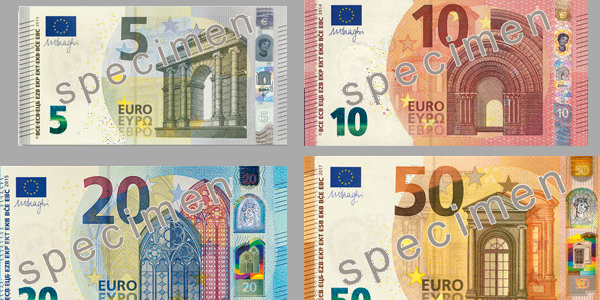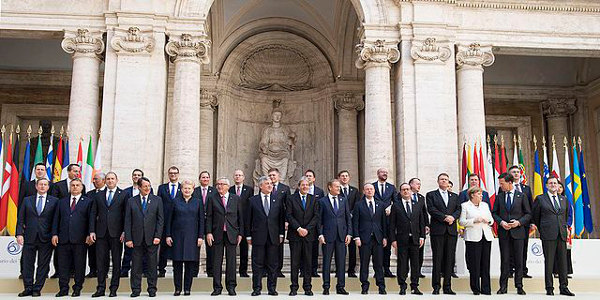Sponsor this page. Your banner or text ad can fill the space above.
Click here to Sponsor the page and how to reserve your ad.
-
Timeline
1999 - Detail
January 1, 1999 - The Euro currency is introduced as a competitive tool to stem the power of the dollar and maximize the economic power of the European Union nations.

The battle of currencies had been waged for decades with the variety of currencies within Europe putting the European nations at a competitive disadvantage due to the complexity of dealing with multiple francs, pesos, guilders, and more in trade transactions. It had been the reason why the dollar, the United States trading unit, had been gaining in popularity throughout the 20th Century in international trade. With the advent of the European Union as a trading collective in 1993, itself an extension of the 1958 Europe Economic Community prompted by the end of World War II between six nations (Belgium, Germany, Luxembourg, France, Italy, Netherlands), the first salvo had been lobbed. They were now the largest trading block in the world. But, without its own currency, it had not been enough.
The goal of a common currency had been discussed since the 1960's, but the political will had not yet evolved. Through the Arab oil crises and the inflationary times of the 1980's, the will grew until the new Treaty of the Economic Union was signed in December 1991 in Maastricht, Netherlands. It set out the goals and timetable of establishing a common currency. The Euro would be launched on January 1, 1999 in eleven member nations (Austria, Belgium, the Netherlands, Finland, France, Germany, Ireland, Italy, Luxembourg, Monaco, Portugal, Spain) plus three non-member states (Monaco, San Marino, and Vatican City), but used for three years for purely accounting and electronic payment purposes. Member Greece would join soon after in 2001. Coins and bills were placed into circulation on January 1, 2002 with twelve member nations participating. The Euro became the sole currency of the region on June 30, 2002. The Euro is divisible into 100 cents, like the dollar. Its name was adopted on December 16, 1995.
Over the next decade, the various nations who adopted the Euro began to retire their previous official currencies with Germany being the first on December 31, 2001 with their German mark.
How the Euro Fared Against the Dollar
Official exchange rates began on January 4, 1999. Some economists forecast that the Euro would gain traction as an reserve currency gradually, and that the introduction of the first major European wide currency since the Roman Empire was good for the stability of the region as well as trade within the Europe economic region.
The initial response was a decline in the Euro versus major currencies, to the low level against the U.S. dollar on October 26, 2000, $0.83. Since 2002, however, it has been valued at above par, $1.00, rising to its highest level during growing concerns about the financial crises in the United States during 2008; on July 18, 2008, the Euro traded at $1.60.
The Euro Today
The Euro in the present is the second most important reserve currency in the world, with over 1.5 trillion Euros in deposit banks. Although the Euro is the official currency of the European Union, of the twenty-eight nations within the collective, nineteen use the Euro as their official currency; Austria, Belgium, Cyprus, Estonia, Finland, France, Germany, Greece, Ireland, Italy, Latvia, Lithuania, Luxembourg, Malta, Netherlands, Portugal, Slovakia, Slovenia, and Spain.
Member nations who are working toward the goal of adopting the Euro as their official currency are Bulgaria, Croatia, the Czech Republic, Hungary, Poland, Romania, and Sweden.
There are non-member states that also currently use the Euro; Monaco, Andorra, San Marino, and the Vatican City. Kosovo and Montenegro also use the currency unilaterally.
The Euro is the daily currency of over three hundred and forty million people. The currency is managed by the European Central Bank headquartered in Frankfurt, Germany.
Photo above: Euro bank notes, 2019. Courtesy Wikipedia Commons. Below: Leaders of the European Union, 2017, Italian G7 Presidency 2017. Courtesy Wikipedia Commons. Info source: "The European Story, Sixty Years of Shared Progress," European Union; "Introducing the Euro," Oanda.com; "International Effects of the Euro," 1999, Robert Solomon, Brookings; Wikipedia Commons.

History
Photo Bomb

The goal of a common currency had been discussed since the 1960's, but the political will had not yet evolved. Through the Arab oil crises and the inflationary times of the 1980's, the will grew until the new Treaty of the Economic Union was signed in December 1991 in Maastricht, Netherlands. It set out the goals and timetable of establishing a common currency. The Euro would be launched on January 1, 1999 in eleven member nations (Austria, Belgium, the Netherlands, Finland, France, Germany, Ireland, Italy, Luxembourg, Monaco, Portugal, Spain) plus three non-member states (Monaco, San Marino, and Vatican City), but used for three years for purely accounting and electronic payment purposes. Member Greece would join soon after in 2001. Coins and bills were placed into circulation on January 1, 2002 with twelve member nations participating. The Euro became the sole currency of the region on June 30, 2002. The Euro is divisible into 100 cents, like the dollar. Its name was adopted on December 16, 1995.
Over the next decade, the various nations who adopted the Euro began to retire their previous official currencies with Germany being the first on December 31, 2001 with their German mark.
The initial response was a decline in the Euro versus major currencies, to the low level against the U.S. dollar on October 26, 2000, $0.83. Since 2002, however, it has been valued at above par, $1.00, rising to its highest level during growing concerns about the financial crises in the United States during 2008; on July 18, 2008, the Euro traded at $1.60.
Member nations who are working toward the goal of adopting the Euro as their official currency are Bulgaria, Croatia, the Czech Republic, Hungary, Poland, Romania, and Sweden.
There are non-member states that also currently use the Euro; Monaco, Andorra, San Marino, and the Vatican City. Kosovo and Montenegro also use the currency unilaterally.
The Euro is the daily currency of over three hundred and forty million people. The currency is managed by the European Central Bank headquartered in Frankfurt, Germany.
Photo above: Euro bank notes, 2019. Courtesy Wikipedia Commons. Below: Leaders of the European Union, 2017, Italian G7 Presidency 2017. Courtesy Wikipedia Commons. Info source: "The European Story, Sixty Years of Shared Progress," European Union; "Introducing the Euro," Oanda.com; "International Effects of the Euro," 1999, Robert Solomon, Brookings; Wikipedia Commons.







